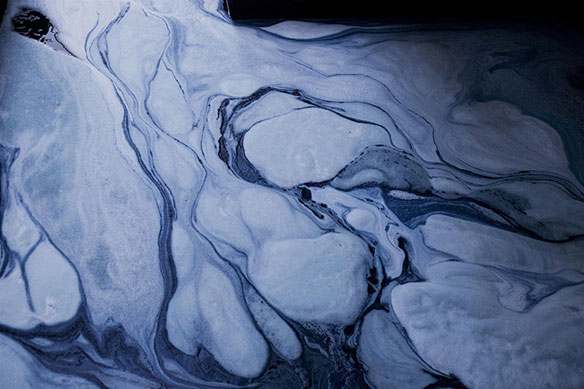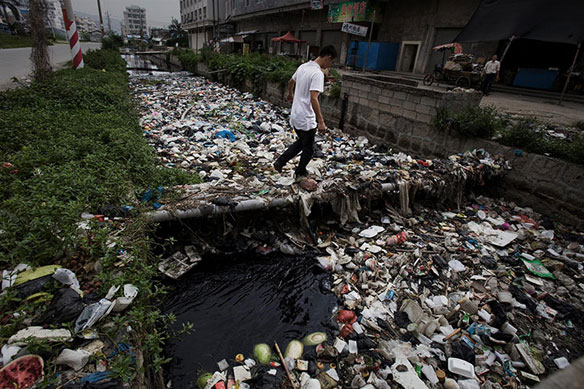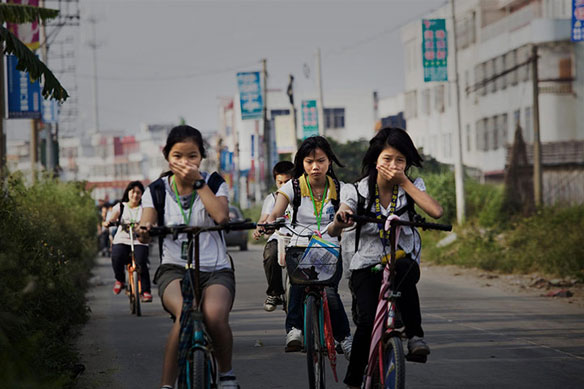
Wastewater discharged from a denim washing factory in Xintang.Villagers complain about the printing and dyeing factories’ wastewater that discharges into the local river, which in turn flows into the Pearl River delta.
Photo Source: Qiu Bo / Greenpeace
A Greenpeace report has called on the Chinese textile industry to clean up its processes after finding high levels of pollution in the southern industrial towns of Xintang – the “jeans capital of the world” – and Gurao, a manufacturing town 80% of whose economy is devoted to bras, underwear, and other clothing articles.
The report said the pollution is emblematic of textile manufacturing in China and the industry must review its practices.
WATCH:
[youtube]http://www.youtube.com/watch?v=6S03LrNlnUc[/youtube]
Toxic runoff from China’s textile industry has made its way into rivers and other waterways. Many are now heavily polluted with chemicals used for dying, printing, bleaching and washing.

A Greenpeace campaigner takes a water sample from a polluted river near Dadun village, Xintang. The charity visited the two towns between April and September last year.
Photo Source: Qiu Bo / Greenpeace.
“Everyone says that people who work in dyeing and washing have reproductive and fertility problems. My cousin once worked in a dyeing plant. He died of pleurisy,” says Lin Zhixin, a migrant worker from Sichuan.
Xintang in Guangdong Province is known as China’s “Jeans Town.” In 2008 it produced 260 million pairs of jeans, making up more than 60 percent of national production and roughly 40 percent of jeans consumption in the United States that year.

A drainage ditch clogged with wastewater and trash in Gurao. Photo Source: Qiu Bo / Greenpeace.
The Dong River running through the town is blackened and covered in foam.
Yan Zhao, Greenpeace Toxics Campaigner:
“We have actually interviewed students who are teenagers and they can’t actually remember the rivers being clean. And of those middle-aged men, they can still remember swimming in those rivers and fishing in those rivers. They can no longer do that anymore. And their children can no longer do that anymore.”
About 186 miles west of Xintang, the town of Gurao produces 200 million bras a year. Its Xiaoxi River is also polluted.
Heavy metals were found in 17 out of 21 samples taken from the Dong and Xiaoxi rivers. Some of the cadmium levels were 128 times the national standard, and the strongly alkaline water reached pH values of nearly 12.
Yan Zhao, Greenpeace Toxics Campaigner:
“Actually, Xintang and Gurao are not unique cases. They are 133 textile industrial clusters like Xintang and Gurao according to the statistics of the China Textile Association. So, we are really afraid that this is just the tip of the iceberg.”
According to the Chinese regime’s National Textile and Apparel Council, the country’s gross output of textiles grew 10 percent in 2009. Most of it is exported to the United States, Europe and Japan.

Students in Gurao try to block out fumes from the trash incineration.
Photo Source: Qiu Bo / Greenpeace
“Xintang and Gurao are emblematic of the larger problem of dirty textile manufacturing – they are just two of 133 textile industrial clusters in the country,” says Greenpeace’s Mariah Zhao. “The responsibility of wastewater regulation and phasing out hazardous chemicals in textiles must be faced by not only Xintang and Gurao overnment but throughout China.”
The price of success: China blighted by industrial pollution , Slideshow, The Guardian UK
Dirty Secrets Behind Jeans and Bras, December 1st 2010 Greenpeace Report









